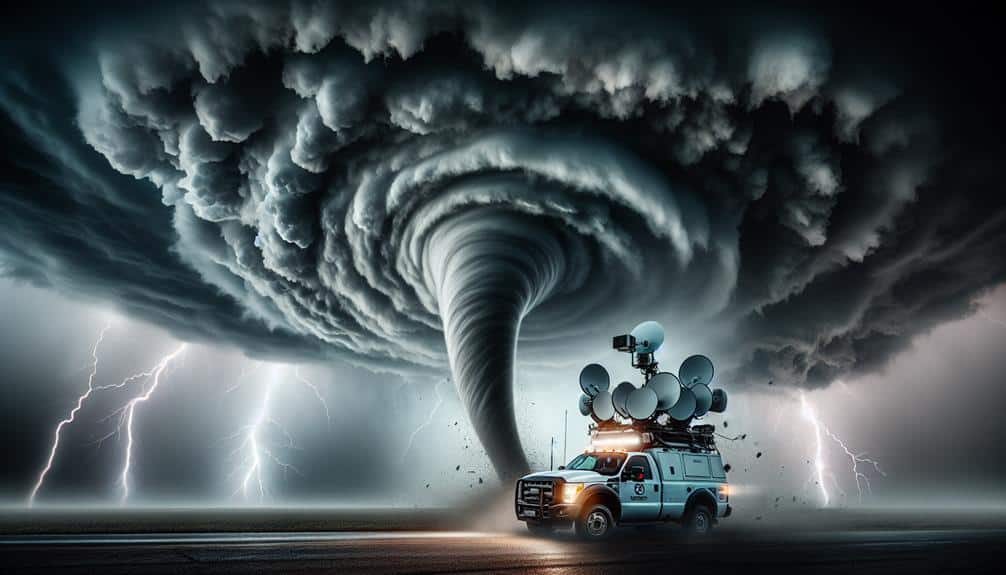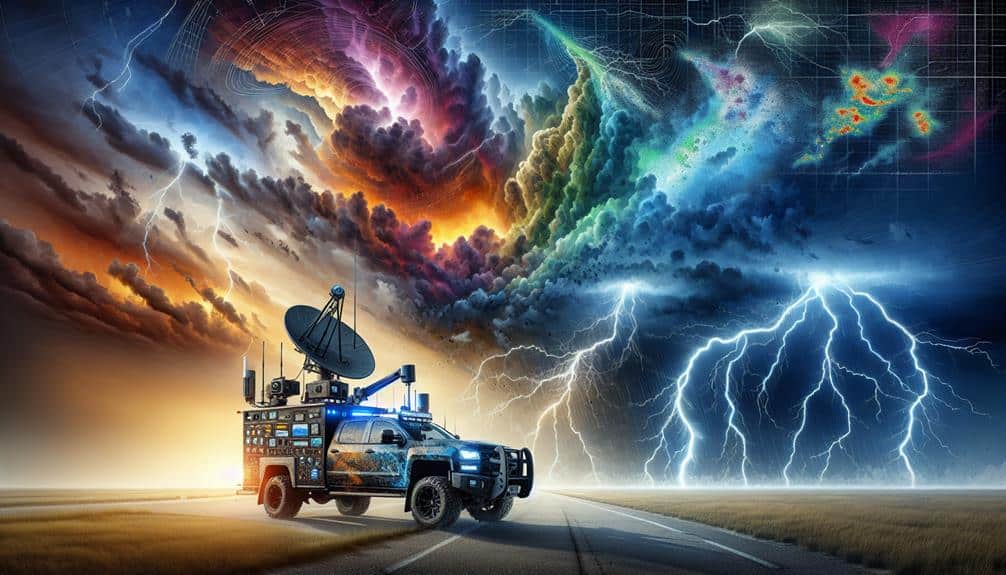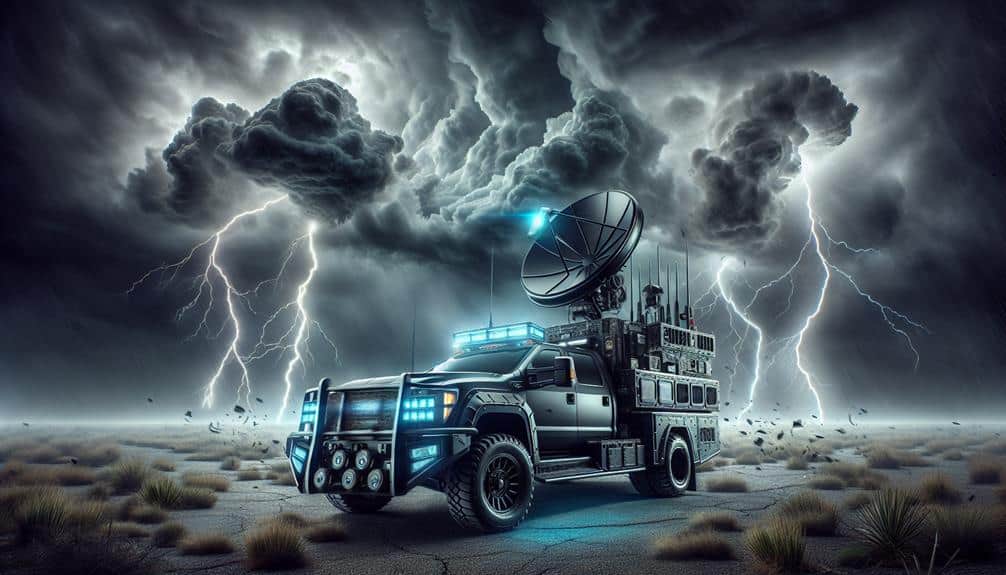Leveraging Doppler radar technology, we revolutionize storm chasing with real-time data and advanced predictive models. This radar uses the Doppler effect to provide accurate measurements of storm speed, direction, and precipitation particle movement. High-frequency scans and machine learning algorithms enhance our ability to track evolving storm dynamics and predict tornado formations. Real-time data visualization and precise storm path forecasting improve our interception strategies. Additionally, analyzing rotational speeds and hook echoes helps identify tornado signatures swiftly, enhancing our safety measures. By continuously updating our models with live data, we achieve unparalleled accuracy in storm chasing—there's much more innovation to explore.
Key Points
- Doppler radar provides real-time storm velocity and direction data for accurate storm tracking.
- Predictive modeling with Doppler radar data forecasts storm paths, enhancing chase strategy.
- High-frequency radar scans and machine learning algorithms improve storm behavior predictions.
- Analyzing rotational speeds and hook echoes with Doppler radar identifies potential tornadic activity.
Understanding Doppler Radar
Doppler radar, leveraging the Doppler effect, measures the velocity and movement of precipitation particles to provide real-time data on storm dynamics. By emitting pulses of microwave radiation, Doppler radar technology detects changes in the frequency of the returned signals. These frequency shifts, known as Doppler shifts, enable us to calculate the speed and direction of storms with precision.
In the field of weather forecasting, Doppler radar technology offers unparalleled advantages. We can pinpoint the exact location and intensity of precipitation, allowing for accurate storm tracking. This capability is essential for severe weather alerts and helps us determine the potential impact on specific areas. By analyzing the velocity data, we also gain insights into wind patterns within the storm system, crucial for predicting tornado formations.
Moreover, Doppler radar technology enhances our situational awareness during storm chases. By integrating this data with other meteorological instruments, we can make informed decisions in real-time. The ability to visualize storm dynamics empowers us to navigate safely and maximize our observational opportunities.
Essentially, Doppler radar technology not only aids in precise weather forecasting but also ensures our freedom to chase storms effectively and safely.
Real-Time Data Analysis
Harnessing Doppler radar's precise storm tracking capabilities, we can now engage in advanced real-time data analysis to monitor and interpret storm developments instantly. By utilizing sophisticated data visualization techniques, we convert raw radar data into clear graphical representations, enabling us to identify storm structures, velocity patterns, and precipitation intensity with exceptional precision. This immediate access to detailed storm characteristics empowers us to make well-informed decisions quickly, improving our storm chase strategies.
Integrating predictive modeling into our analysis, we extrapolate current data to forecast potential storm behavior. By analyzing factors such as wind shear, humidity, and temperature gradients, our models generate probabilistic outcomes, offering insights into storm evolution and possible impact zones. This predictive capability is vital for anticipating severe weather events and optimizing our chase routes.
Our real-time data analysis framework is built on high-frequency radar scans, which refresh every few minutes, ensuring our data remains up-to-date. The incorporation of machine learning algorithms further enhances our predictive models, constantly enhancing their accuracy as more data is processed.
With Doppler radar technology, we achieve a thorough understanding of storm dynamics, granting us the flexibility to chase more efficiently and safely.
Tracking Storm Movement
How do we accurately track storm movement to predict its future path with high precision? Leveraging advanced storm tracking techniques is pivotal.
Using Doppler radar technology, we can analyze real-time data to monitor storm velocity and direction. This radar system measures the frequency shift of returned signals, providing us detailed information on wind patterns and precipitation intensity within the storm cell.
Effective chaser communication plays a crucial role in storm interception. We utilize a network of mobile radar units and chase teams, ensuring that data is continuously shared and updated. This real-time collaboration enables us to adjust our positions strategically and optimize our chances for successful storm predictions and interceptions.
To enhance our storm prediction capabilities, we rely on algorithms that integrate Doppler radar data with meteorological models. These algorithms compute the storm's trajectory, considering variables such as wind shear, moisture levels, and atmospheric pressure. By continuously updating our models with live radar data, we achieve high precision in forecasting storm paths.
Identifying Tornado Signatures
When identifying tornado indicators, we analyze specific Doppler radar patterns such as rotational speeds and hook echoes to identify potential tornadic activity with high accuracy.
Doppler radar advantages become evident when we observe the distinct rotational speeds indicative of tornado formation. By measuring the speed and direction of wind within a storm, we can detect areas of tight rotation, known as mesocyclones, which are often precursors to tornado development.
The hook echo, a radar reflectivity pattern, is another essential indicator in storm detection. This pattern forms when precipitation wraps around the mesocyclone, creating a hook-shaped signature.
By combining data on rotational speeds and hook echoes, we enhance our storm prediction capabilities, allowing us to identify tornadic threats earlier and with greater precision.
Moreover, Doppler radar technology offers us the ability to continuously monitor storm evolution in real-time. This continuous monitoring is vital for accurately tracking storm movement and identifying changes that might lead to tornado formation.
The high spatial and temporal resolution of Doppler radar guarantees that we don't miss significant developments, providing us with the freedom and confidence to make timely, data-driven decisions during storm chases.
Enhancing Safety Measures

In enhancing safety measures, we'll focus on real-time data analysis and early warning systems.
Utilizing Doppler radar technology, we can process live data to track storm movements with high accuracy.
This enables us to issue timely alerts, reducing risks for storm chasers and affected communities.
Real-Time Data Analysis
Leveraging real-time data analysis, we enhance safety measures by rapidly interpreting Doppler radar readings to predict severe weather patterns and issue timely alerts. Real-time data analysis allows us to monitor storm behavior with exceptional precision.
By analyzing velocity data and reflectivity levels, we can discern rotation within thunderstorms, track hail cores, and identify rain bands. This thorough examination of storm signatures directly enhances forecast accuracy, providing actionable insights that inform our chase strategies.
Our approach to data interpretation involves sophisticated algorithms and machine learning models that process vast amounts of radar data in seconds. We utilize this technology to detect minute changes in storm behavior that could indicate the formation of a tornado or a sudden intensification of wind speeds.
By staying ahead of these developments, we greatly reduce risk and improve our ability to make informed decisions. We also integrate multiple data sources, including satellite imagery and ground-based observations, to cross-verify our Doppler radar findings.
This multi-faceted analysis framework ensures that our safety measures are robust and our forecasts are reliable. Ultimately, real-time data analysis empowers us to chase storms with confidence, while prioritizing our safety and optimizing our operational efficiency.
Early Warning Systems
Building on our robust real-time data analysis, our early warning systems further enhance safety measures by providing immediate alerts for impending severe weather events. Leveraging Doppler radar technology, we can achieve precise storm prediction and facilitate rapid emergency response. Our systems are designed to disseminate critical information swiftly, ensuring that communities are well-prepared when severe weather strikes.
For maximum effectiveness, our early warning systems focus on three key areas:
- Storm Prediction Accuracy: By integrating Doppler radar data with advanced algorithms, we can predict storm paths and intensities with exceptional accuracy. This allows us to issue timely warnings that give people the freedom to make informed decisions.
- Emergency Response Coordination: Our alerts are synchronized with emergency services, ensuring that first responders are deployed efficiently. This coordination minimizes response times and maximizes safety for those in affected areas.
- Community Awareness and Weather Preparedness: Public outreach campaigns and educational programs are integral to our approach. By increasing community awareness, we empower individuals to take proactive steps in weather preparedness, ultimately enhancing their resilience against severe weather events.
Incorporating these elements, our early warning systems stand as a demonstration of the power of technology in safeguarding lives while respecting the autonomy of our audience.
Optimizing Chase Strategy
To optimize our chase strategy, we must leverage data-driven route planning to pinpoint the most probable tornado paths.
Real-time weather updates from Doppler radar provide critical information for adjusting our course dynamically.
Data-Driven Route Planning
By integrating real-time Doppler radar data with advanced algorithms, we can enhance storm chase routes to maximize safety and observational effectiveness. Leveraging Doppler radar technology enables us to decipher intricate weather patterns and anticipate storm trajectories with a high degree of accuracy. This data-driven approach empowers us to make informed decisions on-the-fly, improving our ability to navigate the ever-changing dynamics of severe weather systems.
To achieve this, we incorporate the following navigation techniques:
- Real-Time Data Analysis: Continuous monitoring of Doppler radar outputs allows us to identify key weather patterns and track storm movements in real time.
- Predictive Modeling: Advanced algorithms help us simulate storm progression, providing predictive insights that inform our route planning and optimize our ability to stay ahead of developing threats.
- Dynamic Path Adjustment: Leveraging GPS and radar data, we dynamically adjust our routes to avoid hazardous conditions while positioning ourselves for best observation.
Real-Time Weather Updates
Utilizing real-time weather updates, we can continuously refine our chase strategy by integrating the latest Doppler radar data with dynamic modeling tools. These tools enable us to track evolving weather patterns with remarkable precision, enhancing our forecasting accuracy.
As we receive updated radar imagery, we adjust our routes minute-by-minute, ensuring we're in the best position to observe and document severe weather phenomena.
Our ability to access and interpret real-time data isn't only for our chase success but also for broader implications like emergency response and community preparedness. Accurate, up-to-the-minute information allows us to notify local authorities about imminent threats, providing them with the lead time necessary to initiate safety protocols and alert residents.
This real-time data integration can be the difference between a well-executed evacuation and a chaotic scramble for safety.
Future Radar Innovations

Future radar innovations promise to enhance the accuracy and resolution of storm tracking, allowing meteorologists to predict severe weather events with unparalleled precision. With radar advancements and predictive modeling, we can expect a new era in storm prediction and weather forecasting.
First, let's delve into some key developments:
- Phased Array Radar: This technology enables rapid scanning of the atmosphere, notably reducing the time it takes to gather data. It's a game-changer for real-time storm tracking.
- Dual-Polarization Radar: By transmitting both horizontal and vertical pulses, this radar provides detailed information about precipitation type and intensity, improving the accuracy of storm prediction.
- Machine Learning Integration: Advanced algorithms can process vast amounts of radar data, enhancing predictive modeling capabilities and allowing for more precise weather forecasting.
These innovations aren't just technical upgrades; they represent a remarkable leap towards greater freedom in how we prepare for and respond to severe weather. With heightened resolution and faster data processing, we gain the ability to make informed decisions swiftly, potentially saving lives and minimizing property damage.
As we continue to embrace these advancements, our capacity to track and predict storms will only improve, ensuring that we stay ahead of the tempest.
Frequently Asked Questions
How Can Doppler Radar Data Be Accessed by the General Public?
We can access Doppler radar data through various platforms ensuring radar accessibility and public availability. Websites like NOAA, weather apps, and local news channels provide precise, real-time data, empowering us with the freedom to stay informed and safe.
What Are the Costs Associated With Using Doppler Radar Technology?
We need to conduct a thorough cost analysis, considering initial purchase, installation, and ongoing maintenance expenses. Doppler radar technology requires significant investment, but precise data and increased safety justify these costs for those seeking storm-chasing freedom.
Are There Any Mobile Apps That Utilize Doppler Radar for Storm Chasers?
Isn't it amazing how mobile app options enhance our storm chasing? Apps like RadarScope and Storm Shield offer high tracking accuracy, giving us real-time data. With precise terminology and technical details, we gain the freedom to chase safely.
How Do Doppler Radar Systems Handle Extreme Weather Conditions?
Our Doppler radar systems excel in extreme weather conditions. The radar performance remains robust, ensuring accurate weather tracking. Advanced algorithms filter out noise, enabling precise data even during intense storms, empowering us with reliable, real-time information.
What Training Is Recommended for Storm Chasers Using Doppler Radar?
We recommend advanced courses in meteorology and Doppler radar interpretation. Combining this with extensive field experience guarantees proficiency. Practical training in severe weather conditions enhances our decision-making skills and maximizes our storm chase success and safety.


